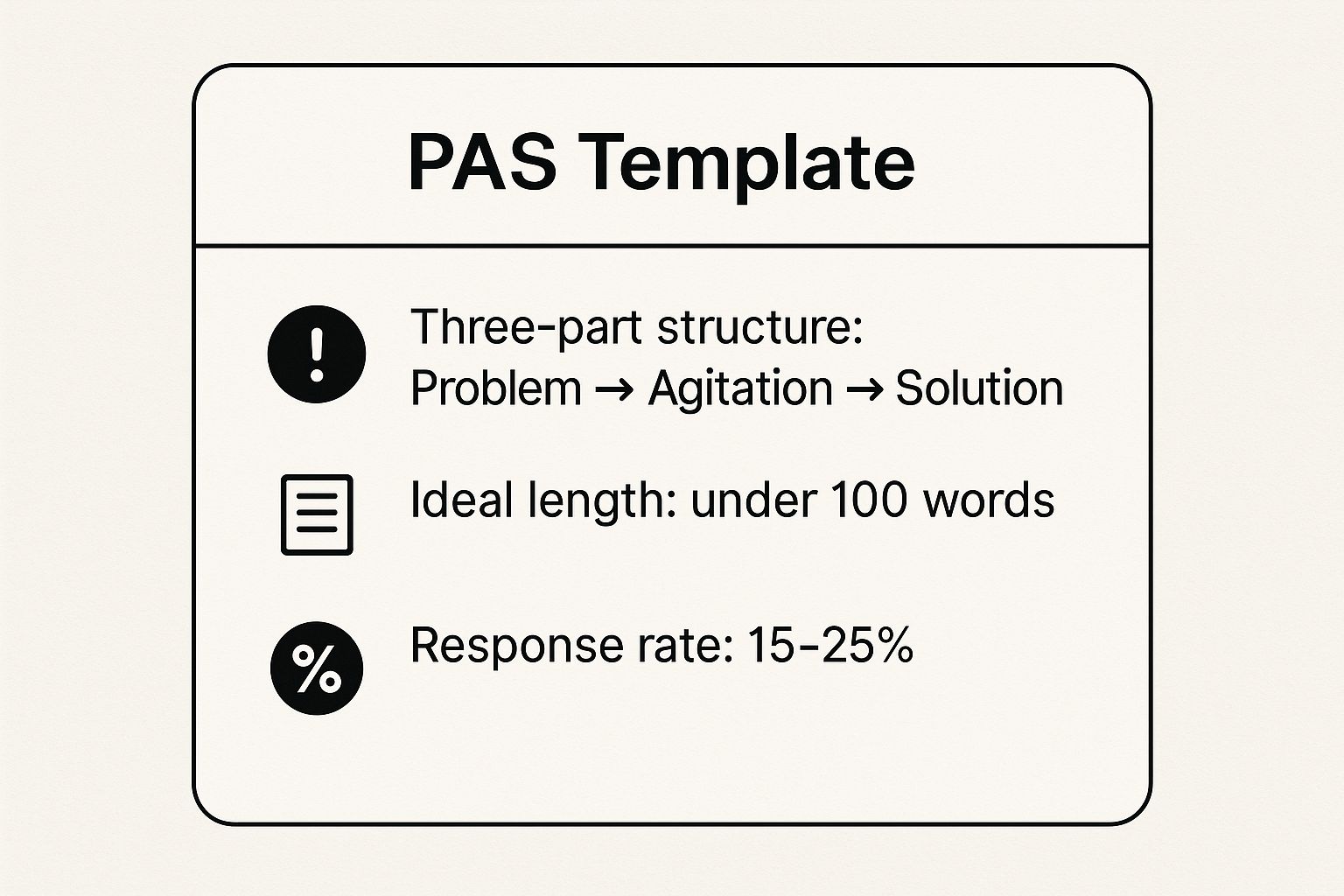Stop Sending Generic Emails: Try These Templates
Tired of low response rates from your cold emails? This listicle provides seven proven cold email templates for sales to help you connect with prospects and close deals. Learn how to use the Problem-Agitate-Solution, Before-After-Bridge, Social Proof, Mutual Connection, Question-Hook, Value-First, and Pattern Interrupt templates. We'll cover the pros and cons, provide examples, share expert tips, and explain ideal use cases for each. Some templates even leverage Salesloop.io features for enhanced automation. Boost your outreach and start seeing results with these effective cold email templates for sales.
1. The Problem-Agitate-Solution (PAS) Template
Crafting compelling cold emails that cut through the noise and generate leads is a constant challenge for sales professionals. One highly effective strategy leverages a classic copywriting framework: the Problem-Agitate-Solution (PAS) template. This approach focuses on resonating with prospects by addressing their pain points directly and positioning your product or service as the ideal solution. If you're looking to boost your cold email open and response rates, the PAS template deserves a prominent place in your sales toolkit.
The PAS template works by first identifying a specific problem your prospect faces. Rather than starting with a generic sales pitch, you demonstrate an understanding of their challenges, immediately grabbing their attention. This establishes a connection and shows you've taken the time to understand their business. The second step involves agitating the pain point. This doesn't mean being overly aggressive or manipulative; instead, it means amplifying the negative consequences of the problem, creating a sense of urgency. Finally, you present your product or service as the solution that alleviates their pain and improves their situation. This three-part structure creates a natural flow that guides the prospect towards considering your offering.
This method is particularly effective because it triggers a psychological response. By acknowledging and emphasizing the prospect's challenges, you establish a shared understanding and build trust. This positions you as a problem-solver, not just another vendor pushing a product. When the identified problem is accurate and relevant, engagement rates can soar. The PAS framework is highly customizable across different industries and pain points, making it a scalable solution for diverse prospect segments. For instance, HubSpot’s sales team has effectively used PAS to address marketing attribution problems, highlighting the difficulty in connecting marketing efforts to revenue and then presenting their software as the solution. Similarly, SaaS companies can target manual process inefficiencies, agitating the wasted time and resources before introducing their automation platform. Consulting firms, on the other hand, can address revenue plateau challenges, amplifying the stagnation before offering their expertise to reignite growth.
However, like any technique, the PAS template has potential drawbacks. If the agitation is too heavy-handed, it can come across as manipulative and damage your credibility. It requires thorough research to understand the prospect’s actual problems, and it might not resonate with prospects who aren't aware of the issue. Furthermore, the popularity of this approach has led some recipients to become skeptical, making it crucial to personalize your message and avoid generic templates.
Here are some tips for effectively using the PAS framework in your cold email templates for sales:
- Be Specific: Use concrete, industry-relevant problems instead of generic pain points. For example, instead of saying "struggling with marketing," say "difficulty tracking ROI on social media campaigns."
- Fact-Based Agitation: Back up your claims with data and statistics rather than relying on emotional manipulation. Quantify the negative impact of the problem whenever possible.
- Soft CTA: Include a soft call-to-action that offers value before pitching your product. This could be a free resource, a consultation, or a case study.
- Personalization: Tailor the problem to the specific company's situation. Research their industry, competitors, and recent news to demonstrate your understanding.
The following infographic summarizes the key aspects of the PAS Template for quick reference:

This infographic visualizes the core components of the PAS template, highlighting its three-part structure, ideal length, and potential response rate. The visualized data emphasizes the concise and impactful nature of the PAS framework while also suggesting the potential for high engagement. When crafted effectively, a well-structured PAS email can be a powerful tool in your sales arsenal.
Learn more about The Problem-Agitate-Solution (PAS) Template
By following these tips and understanding both the advantages and limitations of the PAS template, you can create cold email templates for sales that resonate with prospects, establish trust, and ultimately drive conversions. Remember, the key is to demonstrate genuine empathy and position yourself as a valuable partner in solving their challenges, rather than just another salesperson.
2. The Before-After-Bridge (BAB) Template
The Before-After-Bridge (BAB) template is a powerful framework for crafting compelling cold email templates for sales. It operates on a simple yet effective principle: showcasing the transformation your product or service can deliver. By painting a vivid picture of the prospect's current, less-than-ideal situation (Before), contrasting it with their desired future state (After), and then positioning your offering as the bridge connecting these two points, you create a compelling narrative that resonates with potential clients. This approach moves beyond simply listing features and benefits; it taps into the prospect's aspirations and motivates them to take action.

The BAB template’s visual storytelling structure makes it particularly effective. It allows prospects to visualize the transformation, making the value proposition more tangible and actionable. This future-state visioning approach combined with aspirational messaging and practical steps paints a clear path toward achieving desired outcomes. This isn't about selling a product; it's about selling a solution to a problem. It's about showing the prospect a better version of their business reality and offering them a way to get there.
For example, imagine a Salesforce representative using the BAB template to connect with a potential client. The "Before" might describe the prospect's current struggles with disorganized lead tracking, inefficient communication, and lost sales opportunities. The "After" paints a picture of streamlined processes, improved collaboration, and increased revenue thanks to Salesforce's CRM. The "Bridge" is the implementation and utilization of the Salesforce platform, connecting the current struggles to the desired future.
Similarly, a marketing agency could use this template to demonstrate how they can improve lead generation. The "Before" might highlight the prospect's current stagnant lead flow, low conversion rates, and limited online visibility. The "After" would then showcase a surge in qualified leads, improved brand awareness, and a robust sales pipeline, all achieved through the agency's targeted marketing strategies. The agency itself, with its expertise and services, forms the "Bridge."
Training companies can leverage BAB to showcase team performance transformations. The "Before" might depict a team struggling with low morale, skill gaps, and poor productivity. The "After" presents a high-performing team, equipped with the necessary skills, achieving targets, and contributing significantly to the company's success. The training program, its curriculum, and expert facilitators serve as the "Bridge" to this transformation.
When and why should you use the BAB approach? This template works exceptionally well for transformational products or services, where the value lies in the significant positive change it brings to the customer. It's ideal for situations where you can clearly articulate the problem your solution solves and paint a compelling picture of the improved future state.
Here are some actionable tips for implementing the BAB template effectively:
- Make the 'Before' state specific and relatable: Avoid generic statements. Instead, use specific pain points relevant to the prospect's industry or business. Research their current situation and tailor your message accordingly.
- Ensure the 'After' state is realistic and measurable: While the "After" should be aspirational, avoid over-promising. Focus on achievable outcomes and back them up with data or case studies whenever possible. Use specific metrics or timeframes to make the transformation tangible. For example, instead of saying “increase sales,” say “increase sales by 15% in the next quarter.”
- Position your solution as a proven bridge, not a magic bullet: Explain clearly how your product or service facilitates the transformation. Highlight your expertise, methodology, and successful track record.
- Include a clear call to action: Guide the prospect towards the next step, whether it's scheduling a demo, downloading a resource, or visiting your website.
While the BAB template is a powerful tool for cold emailing, it's important to be aware of its potential drawbacks. If the transformation promises are too ambitious, they can seem unrealistic. It also requires a good understanding of the prospect's desired outcomes, and may not resonate with prospects who are satisfied with the status quo. Finally, the longer format inherent in this approach can sometimes reduce readability if not crafted carefully.
Despite these potential downsides, the BAB framework, popularized by figures like Russell Brunson, Digital Marketer, and Ryan Deiss, remains a valuable asset for crafting compelling cold email templates for sales, helping you connect with prospects on a deeper level and drive conversions.
3. The Social Proof Template
The Social Proof Template is a powerful cold email strategy that leverages the psychological principle of social proof, popularized by Robert Cialdini, to influence potential customers. This principle suggests that people are more likely to adopt a behavior or make a purchase if they see others, especially those similar to themselves, doing the same. In the context of sales, this translates to showcasing how other businesses, ideally within the prospect's industry or facing similar challenges, have benefited from your product or service. By demonstrating tangible results and leveraging recognizable names, this template reduces perceived risk and builds immediate credibility, making your cold email more persuasive and increasing the likelihood of a positive response.

This template operates on a credibility-first approach. Instead of leading with a hard sell, you begin by establishing trust and demonstrating value. This is achieved by highlighting specific metrics and results achieved by other companies using your solution. By employing a peer comparison methodology, you allow prospects to see themselves in the success stories you present, further strengthening the persuasive power of your message. This focus on risk reduction directly addresses a key barrier to conversion in cold outreach: the inherent hesitation of trying something new.
The Social Proof Template boasts several advantages. It builds immediate trust and credibility, which is crucial in the impersonal world of cold emailing. By showcasing success stories, you significantly reduce the perceived risk associated with adopting a new solution. This can also create a Fear Of Missing Out (FOMO) effect, prompting prospects to engage with your offering to avoid being left behind. Furthermore, this template's versatility allows it to work across various industries and company sizes, making it a valuable tool for a broad range of sales professionals.
However, this template also comes with its potential drawbacks. It relies heavily on having compelling and relevant case studies. Without impressive, quantifiable results to showcase, the impact of this template is significantly diminished. Moreover, if not carefully crafted, highlighting other companies' success can come across as boastful or even disingenuous. To mitigate this, focus on the genuine value provided and avoid overly exaggerated claims. The effectiveness also diminishes if the social proof isn't derived from companies similar to the prospect. A small startup, for instance, might not be persuaded by the success story of a Fortune 500 company. Finally, unsubstantiated claims, particularly about competitor success, can be challenged and potentially damage your credibility. Always ensure you have the data to back up your statements.
Consider these examples of successful Social Proof Template implementations: Slack might reference how Airbnb improved internal communication and streamlined workflows using their platform; Marketing automation tools could highlight competitor success stories, showcasing how similar businesses achieved significant increases in lead generation or conversion rates; Consulting firms could present quantifiable results achieved for Fortune 500 clients, emphasizing the value and ROI they deliver.
To effectively leverage the Social Proof Template in your cold email campaigns, follow these tips:
- Target Relevance: Use examples from the prospect's direct competitors or aspirational companies. This increases the relevance and impact of the social proof.
- Quantifiable Results: Include specific, verifiable metrics and results. Instead of vague statements, use concrete numbers to demonstrate the value proposition. For example, instead of saying "improved efficiency," state "reduced customer onboarding time by 30%."
- Timeframes: Mention the timeframe within which these results were achieved. This adds further credibility and sets realistic expectations.
- Permission: When possible, obtain permission from clients to use their names and testimonials. This enhances trust and demonstrates ethical practices.
The Social Proof Template has been effectively utilized by industry leaders like the Salesforce Marketing Team and HubSpot, further solidifying its place as a powerful tool in cold email outreach. This template deserves its place in any sales professional’s toolkit due to its ability to quickly establish credibility, reduce perceived risk, and ultimately, increase conversions. By thoughtfully incorporating this strategy into your cold email campaigns, you can significantly enhance your outreach efforts and achieve greater success in connecting with and converting prospects. This template is particularly beneficial for solo sales professionals, small to medium-sized B2B sales teams, marketing agencies, sales enablement managers, and even large enterprises seeking to improve their cold outreach effectiveness.
4. The Mutual Connection Template
The Mutual Connection Template stands out among cold email templates for sales due to its ability to transform a cold outreach into a warm introduction. This approach leverages shared connections, experiences, or communities to establish immediate rapport and trust with your prospect. Instead of reaching out cold, you’re effectively getting a warm referral by mentioning a mutual contact, shared alma mater, professional association, or even a common experience. This instantly boosts your credibility and dramatically increases open and response rates, making it a powerful tool in your sales arsenal.
This relationship-leveraging approach works by invoking the principle of trust transfer. When you mention a mutual connection, you’re borrowing some of the trust and goodwill that your prospect already has for that person. This bypasses the initial skepticism that often accompanies cold outreach and opens the door for a more receptive conversation. It's a warm introduction methodology that uses your network as a foundation for prospecting, turning cold leads into warm prospects.
Why use the Mutual Connection Template?
This template is particularly effective when targeting high-value prospects or decision-makers who are typically inundated with cold emails. The personalized touch of mentioning a shared connection cuts through the noise and grabs their attention. It also provides a natural conversation starter, facilitating a smoother transition into your sales pitch. Often, this translates to faster sales cycles as the initial trust-building phase is significantly shortened.
Examples of Successful Implementation:
- LinkedIn Sales Navigator Mutual Connection Outreach: LinkedIn is a goldmine for finding mutual connections. Sales Navigator allows you to filter your searches and identify prospects who share connections with you. You can then personalize your outreach by mentioning the shared connection and how you know them.
- Alumni Network-Based B2B Prospecting: Leveraging your alumni network can be incredibly effective, especially when targeting businesses in specific industries. Mentioning your shared alma mater creates an immediate bond and can open doors to otherwise inaccessible prospects.
- Industry Conference Follow-Up Emails: Conferences provide excellent opportunities to network and build connections. Following up with new contacts after a conference, mentioning your shared experience, reinforces the connection and paves the way for future business opportunities.
Actionable Tips for Using the Mutual Connection Template:
- Always Get Permission: When possible, reach out to your mutual connection beforehand and ask for their permission to mention them in your outreach. This demonstrates respect and avoids putting them in an awkward position.
- Be Specific: Don't just mention the name of the mutual connection. Be specific about how you know them. For example, “I noticed we both know John Smith from our time at Acme Corporation.” This adds authenticity and strengthens the connection.
- Keep it Natural: The mention of the mutual connection should feel natural and organic, not forced or contrived. Weave it seamlessly into your message, making it relevant to the conversation.
- Follow Up with the Connector: Maintain your relationship with the mutual connection by letting them know you reached out to their contact. This keeps them in the loop and strengthens your network.
Pros and Cons:
Pros:
- Dramatically higher open and response rates
- Instant credibility and trust establishment
- Natural conversation starter
- Often leads to faster sales cycles
Cons:
- Requires extensive network research
- Limited scalability due to connection requirements
- May strain relationships if overused
- Doesn't work for broad, untargeted campaigns
While the Mutual Connection Template may not be suitable for broad, untargeted campaigns, it's an invaluable tool for targeted outreach, particularly when dealing with high-value prospects. By leveraging your existing network and building on established relationships, you can significantly improve your chances of converting cold leads into paying customers. Learn more about The Mutual Connection Template For sales professionals, freelancers, B2B sales teams, marketing agencies, and even large enterprises, this personalized approach can be a game-changer in the competitive world of sales. It’s a powerful reminder that sometimes, the warmest leads are just a connection away.
5. The Question-Hook Template
The Question-Hook Template stands out among cold email templates for sales due to its interactive and engaging nature. Instead of launching directly into a product pitch, this template leads with a thought-provoking question designed to pique the prospect's curiosity and encourage a response. This approach leverages the ingrained human tendency to answer questions, fostering engagement through genuine curiosity rather than high-pressure sales tactics. It’s particularly effective for initiating conversations, building relationships, and positioning yourself as a consultant rather than just another salesperson.
This method works by tapping into the psychology of curiosity. A well-crafted question disrupts the monotony of a prospect's inbox and compels them to consider the implications. This mental engagement makes them more receptive to your subsequent message and increases the likelihood of a response. Instead of being presented with a solution they may not even know they need, the question prompts them to self-identify potential challenges or opportunities, creating a more natural entry point for your sales pitch.
The Question-Hook Template excels in several key areas:
- Curiosity-driven Opening: The initial question acts as a hook, grabbing attention and drawing the prospect into the conversation.
- Interactive Dialogue Starter: Unlike traditional one-way sales pitches, this template invites a response, initiating a two-way dialogue from the outset.
- Psychology-based Engagement: By leveraging the natural human inclination to answer questions, this template bypasses resistance and fosters genuine engagement.
- Consultative Selling Approach: By focusing on the prospect's challenges and goals, the Question-Hook Template positions you as a helpful consultant rather than a pushy salesperson.
Consider these examples of successful implementations:
- Focusing on Challenges: "What's your biggest challenge with customer retention this quarter?" This question directly addresses a potential pain point, encouraging the prospect to articulate their specific struggles and opening the door for you to offer solutions.
- Targeting ROI: "How are you currently measuring ROI on your marketing spend?" This question targets a crucial business metric, prompting reflection on current processes and potentially revealing areas for improvement where your product or service can add value.
- Highlighting Potential Gains: "What would 20% faster delivery times mean for your customer satisfaction?" This question encourages the prospect to visualize the positive impact of a specific improvement, making the benefits of your offering more tangible and appealing.
While the Question-Hook Template offers significant advantages, it's important to be aware of its potential drawbacks:
- Relevance is Key: Questions must be genuinely valuable and relevant to the prospect's business. Generic or poorly researched questions can appear insincere and damage your credibility.
- Avoid Obvious Manipulation: Overly simplistic or leading questions can come across as manipulative and deter engagement. Strive for insightful inquiries that demonstrate genuine interest.
- Requires a Follow-up Strategy: Be prepared to engage in a meaningful conversation based on the prospect's response. A well-defined follow-up strategy is crucial for maximizing the effectiveness of this template.
- Not Always Suitable for Busy Executives: Time-constrained executives may not have the bandwidth to engage with open-ended questions. Consider a more direct approach for this audience.
To effectively utilize the Question-Hook Template in your cold email templates for sales, follow these tips:
- Focus on Insight: Ask questions that reveal valuable insights for the prospect, demonstrating that you understand their industry and their challenges.
- Open-Ended Questions: Favor open-ended questions that encourage thoughtful responses over simple yes/no questions.
- Thorough Research: Base your questions on genuine industry research and tailor them to the specific prospect's business.
- Prepare Follow-Up Questions: Anticipate potential responses and prepare thoughtful follow-up questions to keep the conversation flowing and deepen engagement.
This approach draws inspiration from established sales methodologies like the Dale Carnegie principles, SPIN Selling, and the Challenger Sale, which emphasize the importance of understanding customer needs, building rapport, and offering valuable insights.
By implementing the Question-Hook Template effectively, you can transform your cold email outreach from a one-way pitch into an engaging two-way conversation, increasing your response rates and ultimately driving sales success. Remember to always prioritize genuine curiosity and value in your questions to build trust and establish yourself as a trusted advisor.
6. The Value-First Template
In the competitive world of sales, cutting through the noise of generic cold emails is crucial. The Value-First Template offers a powerful approach to cold email outreach that prioritizes providing genuine value to the prospect before making any sales pitch. This method flips the traditional sales script on its head, focusing on building goodwill and establishing expertise first, and asking for something later. It's a strategy particularly effective for solo sales professionals and freelancers, small-to-medium sized B2B sales teams, marketing and lead generation agencies, sales operations and enablement managers, and even enterprise organizations seeking fully managed outreach services. It's a smart way to differentiate yourself from the deluge of "me-focused" cold email templates for sales and establish yourself as a trusted resource.
Instead of leading with a sales pitch, the Value-First Template opens by offering something immediately beneficial to the recipient. This "give-before-you-get" philosophy centers around providing valuable insights, resources, or actionable tips that directly address the prospect's needs and challenges. This could take many forms, such as sharing exclusive industry reports or benchmarks, offering a free consultation or audit, providing valuable introductions to other contacts, or sending customized recommendations based on publicly available information about their company or role. The key is to make the value tangible, relevant, and readily applicable.
The power of this approach lies in its ability to build positive associations with your brand and position you as a thought leader. By demonstrating expertise and genuine interest in the prospect’s success, you create a sense of reciprocity. While it may not immediately generate sales conversations, the long-term benefits are substantial. You cultivate a relationship based on trust and mutual benefit, increasing the likelihood of conversion down the line.
Examples of Successful Implementation:
- A cybersecurity firm could send a personalized cold email to a CIO highlighting vulnerabilities detected in their company's public-facing web applications, offering a free vulnerability scan as a next step.
- A marketing agency specializing in SEO could share a customized content strategy outline based on the prospect's existing website, offering a free consultation to discuss further improvements.
- A SaaS company could offer a free trial of their software along with a curated list of resources tailored to the prospect’s specific industry and pain points.
- A sales consultant could offer to introduce the prospect to a relevant contact in their network who could help them solve a specific business challenge.
Actionable Tips for Using the Value-First Template:
- Relevance is Key: Ensure the value you offer is directly relevant to the prospect’s industry, role, and current challenges. Generic advice or resources will likely be ignored. Research your prospects thoroughly.
- Don’t Expect Immediate Returns: This is a long-term play. Focus on building relationships, not closing deals instantly. Patience is essential.
- Follow Up Strategically: Provide additional value before making any sales asks. Nurture the relationship with consistent, valuable content.
- Track and Measure: Monitor which types of value generate the best responses and refine your approach accordingly. What resonates with one industry might not work for another.
- Personalize, Personalize, Personalize: Tailor the value offering to each individual recipient. The more personalized the better.
Pros and Cons of the Value-First Template:
Pros:
- Builds Goodwill and Positive Associations: Positions your brand as helpful and trustworthy.
- Demonstrates Expertise and Thought Leadership: Establishes credibility and builds confidence.
- Creates Reciprocity Principle Activation: Increases the likelihood of future engagement.
- Differentiates from Typical Sales Approaches: Cuts through the noise of generic sales pitches.
Cons:
- Requires Significant Upfront Investment in Value Creation: Developing valuable resources and insights takes time and effort.
- May Not Immediately Generate Sales Conversations: Requires a longer-term perspective on ROI.
- Value Must Be Genuinely Useful to Be Effective: Superficial attempts at value-adding will backfire.
- Longer Sales Cycle Due to Relationship Building Approach: This approach isn't suited for quick wins.
This method, popularized by figures like Gary Vaynerchuk and his "Jab, Jab, Jab, Right Hook" methodology, and Adam Grant’s work on reciprocity, emphasizes giving value upfront. It’s about building genuine connections and fostering trust. Learn more about The Value-First Template. While it requires more upfront effort than traditional cold email templates for sales, the long-term payoff in terms of building relationships and generating qualified leads can be significantly higher. By consistently delivering value, you position yourself not just as a salesperson, but as a valuable resource and trusted advisor.
7. The Pattern Interrupt Template
In the crowded landscape of B2B sales, grabbing a prospect's attention with cold emails is more challenging than ever. Traditional templates often blend into the background noise, leading to low open and response rates. This is where the Pattern Interrupt Template comes in, offering a refreshing and often highly effective approach to cold email outreach. This template disrupts the monotony of typical inbox clutter by introducing unexpected elements that jolt the reader out of their usual scanning routine. It's a powerful technique for cold email templates for sales, designed to spark curiosity and encourage engagement, making it a worthy addition to any sales professional's toolkit.
The core principle behind the Pattern Interrupt Template is leveraging the element of surprise. By deviating from standard email formatting, subject lines, and overall tone, you capture the prospect's attention and compel them to read further. This "cognitive disruption" technique works because our brains are naturally drawn to novelty. When something breaks the expected pattern, it triggers our attentional system, making us more likely to notice and process the information.
This template isn't about being outlandish or unprofessional; rather, it’s about strategically using unexpected elements to make your message stand out while still maintaining a clear and relevant connection to your value proposition. This could involve a variety of tactics, from incorporating unusual formatting and creative structure to injecting humor and utilizing surprising statistics. The ultimate goal is to be memorably different without sacrificing professionalism.
Examples of Successful Pattern Interrupts:
- Unexpected Subject Lines: Instead of generic subject lines like "Introducing [Your Company]," try something like "This might be a terrible idea… (but hear me out)" or "[Prospect Name], I found something you might hate." The goal is to pique their curiosity and make them want to open the email to understand the context.
- Visual Disruptions: Incorporate visuals like GIFs, relevant memes (used cautiously and appropriately), or even a thumbnail image of a personalized video in your email signature. These visual elements break up the text and create a more engaging experience. Sending an image of a handwritten note can also add a personal touch, although it's crucial to ensure it aligns with your brand and target audience.
- Unconventional Formatting: Experiment with bolding unusual phrases, using different font sizes, or incorporating emojis (again, with careful consideration of your target audience). You could even structure your email like a short story or a news article to further disrupt expectations.
- Surprising Statistics: Start your email with a shocking or counter-intuitive statistic related to the prospect's industry. This immediately grabs their attention and positions you as someone with valuable insights.
Actionable Tips for Using the Pattern Interrupt Template:
- Know Your Audience: While creative disruption can be highly effective, it's crucial to tailor your approach to your target audience. A quirky, meme-filled email might resonate with a startup founder but fall flat with a corporate executive in a conservative industry.
- Test and Iterate: Start by testing pattern interrupts with small segments of your audience to gauge their effectiveness. A/B testing different subject lines, formats, and content variations will help you identify what resonates best.
- Maintain Professionalism: While the goal is to be different, it's essential to maintain a professional core message. The pattern interrupt should enhance your message, not overshadow it. Ensure your value proposition and call to action remain clear and concise.
- Don't Overdo It: The power of pattern interrupts lies in their novelty. Overusing them can lead to diminishing returns and even make your emails seem gimmicky. Use them strategically and sparingly for maximum impact.
Pros and Cons of the Pattern Interrupt Template:
Pros:
- High open rates due to the curiosity factor
- Memorable and shareable content
- Effective in crowded, competitive markets
- Can showcase company culture and creativity
Cons:
- Risk of seeming unprofessional or gimmicky if poorly executed
- May not work with conservative industries
- Difficult to scale while maintaining uniqueness
- Can backfire if the execution is poor or misaligned with the audience
The Pattern Interrupt Template is a valuable tool for cold email templates for sales because it directly addresses the challenge of cutting through inbox noise. When used effectively, it can significantly boost your open and response rates, ultimately leading to more qualified leads and closed deals. However, it's essential to use this technique thoughtfully and strategically. By understanding your audience, testing different approaches, and maintaining a professional core message, you can harness the power of pattern interrupts to create truly engaging and effective cold emails.
Cold Email Templates Comparison Guide
| Template | 🔄 Implementation Complexity | 🛠️ Resource Requirements | 📊 Expected Outcomes | 💡 Ideal Use Cases | ⭐ Key Advantages |
|---|---|---|---|---|---|
| Problem-Agitate-Solution (PAS) | Medium – needs deep prospect research and careful agitation balance | Moderate – requires customization and research | 15-25% response rate | Enterprise B2B sales with complex problem-solving | Creates emotional connection; scalable |
| Before-After-Bridge (BAB) | Medium-High – needs clear visualization and realistic transformation | Moderate – requires insight into prospect's desired outcomes | 18-22% response rate | Growth-focused companies aiming for big improvements | Powerful outcome visualization; aspirational messaging |
| Social Proof | Low-Medium – depends on availability of strong case studies | Low-Moderate – needs credible social proof assets | 20-30% response rate | Competitive markets where trust is critical | Builds trust quickly; reduces perceived risk |
| Mutual Connection | High – requires extensive network research and personalized intros | High – depends on network leverage and warm referrals | 35-50% response rate | High-value relationship-driven B2B sales | Dramatically higher response rates; instant trust |
| Question-Hook | Low-Medium – crafting good questions and follow-up strategy | Low – research-driven but lightweight execution | 25-35% response rate | Complex B2B sales needing consultative approach | Encourages two-way engagement; consultative |
| Value-First | Medium-High – upfront investment in real value creation | High – requires creation of useful resources and insights | 20-25% response rate (long-term) | High-value B2B with long sales cycles | Builds goodwill; demonstrates expertise |
| Pattern Interrupt | Medium – creative but risky, needs careful audience targeting | Moderate – creative assets and testing needed | 30-40% open, 15-20% response rates | Competitive markets with casual, younger decision makers | High curiosity and memorability; stands out |
Elevate Your Outreach with Salesloop.io
From the problem-agitate-solution (PAS) framework to the pattern-interrupt method, this article has explored seven powerful cold email templates for sales, providing you with a robust foundation for effective outreach. Mastering these templates and understanding which approach resonates best with your target audience is crucial for maximizing open rates, click-through rates, and ultimately, conversions. The key takeaway is this: personalization and providing genuine value are paramount. Whether you're leveraging social proof, highlighting a mutual connection, or simply asking a compelling question, focusing on the recipient's needs will always yield the best results.
Leveraging effective cold email templates is just one aspect of successful sales outreach. To truly maximize your results, consider incorporating broader strategies such as robust data analysis and business intelligence to inform your targeting and messaging. This data-driven approach, as highlighted by Master Data Analysis and Business Intelligence from Kleene.ai, can significantly improve your conversion rates and overall sales performance.
By implementing these strategies, you can transform your cold outreach from a scattershot approach to a highly targeted, efficient process that generates qualified leads and drives revenue growth. Remember, effective communication is the cornerstone of any successful sales strategy, and these templates provide the building blocks for building strong relationships with potential clients.
Ready to supercharge your outreach and streamline your sales process? Salesloop.io seamlessly integrates these powerful cold email templates for sales with advanced automation and personalization features, allowing you to scale your outreach efforts while maintaining a personal touch. Explore the power of Salesloop.io today and revolutionize your sales game in 2025. Salesloop.io





